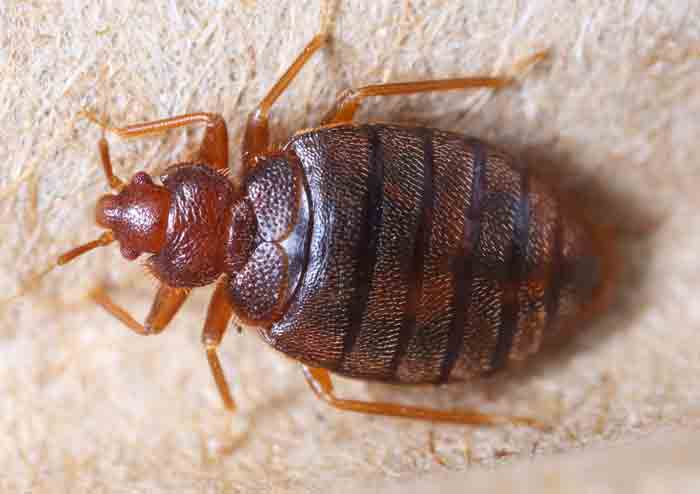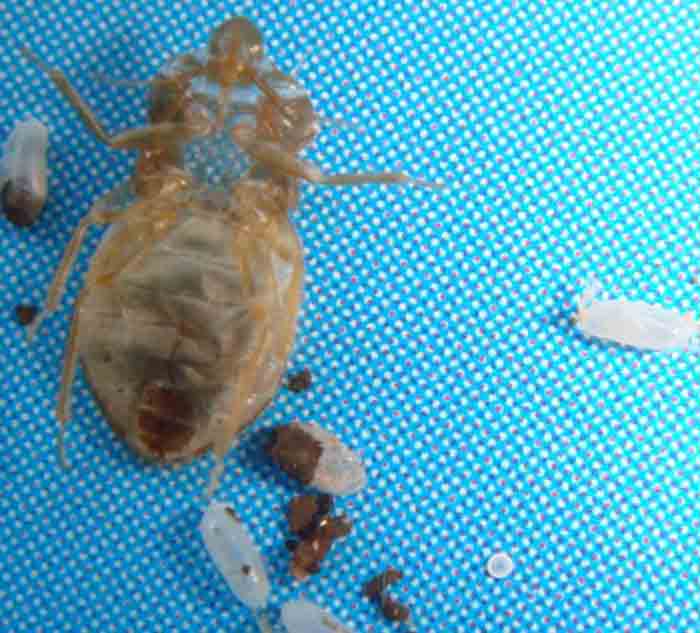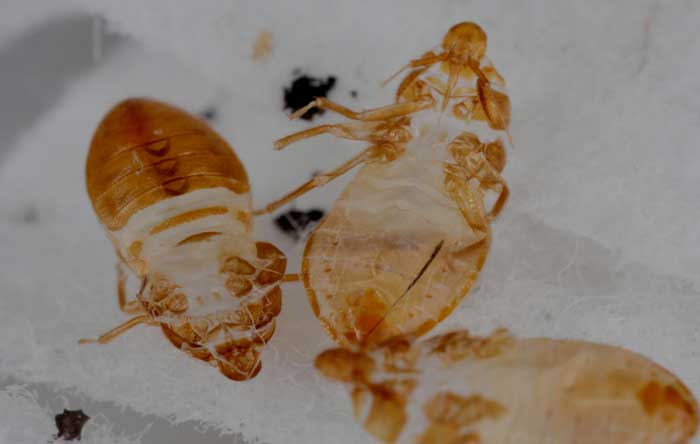A bed bug shell is the outer part (exoskeleton) of the bed bug that has been shed. Like any other insect, bed bugs do shed their skin to facilitate growth.
All through the bed bug life cycle, bed bugs molt. Molting refers to shedding of the bed bug skin. Shedding of the skin from infancy to adulthood involves five phases of shedding the bed bug skin.

Baby bed bugs or nymphs; shed their skin as they approach adulthood. The nymphs shed their external skin severally before getting to their mature age.
In fact, the number of estimated times that bed bugs shed their shells is five times. For every fresh growth level, the bed bugs will shed their skin once.
A bed bug that has newly shed its skin can be noticed since its skin appears new. Such bed bug’s skin resembles that of a brighter colored bed bug shell or skin.
Once you find bed bug shells in your house, you need to get worried. It is an indicator that the house is heavily infested and the bed bugs may have been in your house for some time now.
The process of bed bugs shedding their skin is referred to as molting as mentioned above but others refer to the process as ecdysis. Under ideal conditions, it takes a week for a bed bug to complete a certain stage in their life cycle.
However, this is determined by a number of factors such as temperature and how easily and often the bed bug accesses a blood meal.
Table of Contents
What do bed bug shells look like
Bed bug shells appear as clear exoskeletons which are empty. Bed bug shed skin is found in clusters and since the shells do not decompose at the same time, they may start to build up.
The skin that bed bugs shed resembles a live bed bug and the two are at times confused. The shed skin looks like the bed bug’s full suit that has been taken off. Nevertheless, there are distinct differences such as; the skin is empty and translucent.
Another obvious difference is that while a live bed bug moves, the skin that looks like a bed bug does not move.
These differences are very important so that you do not confuse a live bed bug for its skin. Always look keenly to ensure you know when it is a live bed bug and when it is its ‘full suit’.
Just like bed bug droppings, bed bug shells are used as a sign that shows a possibility of bed bug infestation in your home. It is therefore prudent to know how they look like.
Where an infestation is new, there will be few traces of shed skin unlike the case of an old infestation where there may be plenty of the bed bug shells.
A new infestation has fewer shells since adult bed bugs don’t molt. It is only after the female bed bugs lay eggs and they hatch that you will start seeing an increase in the number of shells. This is because the bigger population will now constitute nymphs.
The bed bug skin is commonly found under your carpet or on its edges, in your telephone, your radio, in your books, in the box spring, and around wood framing.
When looking for bed bug shells, however, ensure you check every part of your house and not just the mentioned places.
Bed Bug Exoskeleton Pictures
Further Reading
- Can Bed Bugs live on or Bite Dogs & Cats (Pets)?
- Bugs that look like Bed Bugs-Beetles & Others that Resemble or Mistaken
- Bed Bug Bombs-Do Foggers work? Effectiveness & Reviews
- Bed Bug Repellents -Natural Homemade, Creams, Electronic & Reviews
- How do Bed Bugs Spread? Are they Contagious? How Fast/Easily from Person, Room or House?
- Best Bed Bug Sprays-DIY Homemade, Natural, Brand Reviews
- Flea Bites vs Bed Bug Bites + Differences & Pictures
- How to Prevent Bed Bugs-Bites while Sleeping at Home, School, Hotel & Travelling
- How to get rid of Bed Bugs on Clothes-Can they Live, Bite through or Travel on Laundry
- Fumigation for Bed Bugs-Cost & Preparation
- How to get Bed Bugs out of Carpet with Cleaner & Powder
- How Long do Bed Bugs Live Without Food, Host, Air, in Cold & After Spraying
- Bed Bug Rash on Skin, Pictures, Treatment, Allergy & Symptoms
- Where do Bed Bugs Hide and how to Find them
- Mosquito Bites vs Bed Bug Bites-What’ are the differences
- Identifying Bed Bug Eggs- How they look like, Images & destruction
- How do you know if you have Bed Bugs-Symptoms & Signs
- Bed Bug vs Spider Bites- Differences with Pictures
- Bed Bug Sniffing Dogs-How they smell, Sense, Roscoe, Breeds & Cost
- What are Bed Bugs? Names in other Languages
- Where do Bed Bugs come from? Causes, how you get them & Start
- How to Kill/Get Rid of Bed Bugs Fast Yourself Naturally for Good
- Bed Bugs in Hair Symptoms, Pictures & Get rid
- Types of Bed Bugs
- Bed Bug Poop/Droppings-How it looks like, Pictures +Identification
- Bed Bug Shells, Cast Skin & Exoskeleton
- Can you See Bed Bugs with the Naked eye? Pictures, Size, Color & Anatomy
- Dust Mite vs Bed Bug Bites
- Bed Bug life cycle-Eggs, Baby(Nymph) to Adult Stages & Pictures
- How to Detect Bed Bugs-Detectors, Light & Verifi Reviews
- How to know if Bed Bugs are gone after Treatment & what to do
- Will Bleach Kill Bed Bugs-How does it work?
- Best Bed Bugs Traps- DIY Homemade, Co2, Yeast + Reviews
- How to Deal with Bed Bugs in your Car
- Bed Bugs in Couch-Covers, Signs & How to Get rid
- How to Kill Bed Bugs with Steam: Best Steamers & Guide + Tips
- Does Alcohol Kill Bed Bugs? Rubbing, Isopropyl & Percentage
- How Long do Bed Bug Bites Last, Take to Appear, Go Away & Heal
- Natural Predator of Bed Bugs-What Insects/Bugs eat Bed Bugs?
- Can Bed Bugs Live in TVs & Other Electronics? How to get them out
- Do Bed Bug Bites Itch or Hurt?
- Bed Bug Interceptor-How it works, DIY & Reviews
- What do Bed Bug Bites look like? Pictures & Identification Steps
- What Attracts Bed Bugs & things they Hate /Dislike Most
- Can Bed Bugs make you Sick? How are they Dangerous?
- Can Bed Bugs Fly-Do they have Wings-How Far can they Travel
- Diatomaceous Earth for Bed Bugs-How to Use & Best Reviews
- DIY Bed Bug Heat Treatment: Success Rate,Temperature Chart, Preparation & Reviews
- Does Vinegar Kill Bed Bugs? Can it be Used for Bites?
- How to Get Rid of Bed Bugs on Mattress- Best Covers, Protectors & Encasement Reviews

